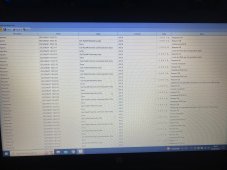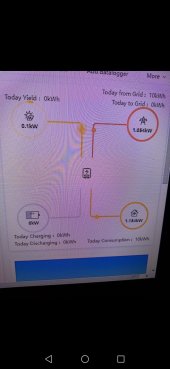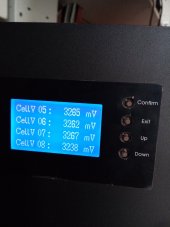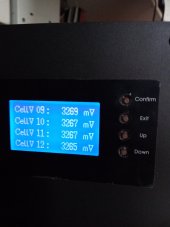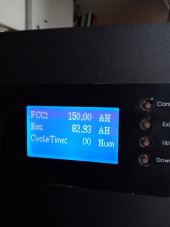Sanwizard
Solar Wizard
- Joined
- Feb 2, 2021
- Messages
- 2,733
Interesting results. I have reservations on needing the BMS settings to make the inverter to stop charging when hitting set limits, especially when you add additional batteries. I have seven Seplos of mixed BMS versions (C and D).And an update with the above settings.
The battery was charging at full speed (3kW, this is what the inverter can supply) until the 3.45V cell/55.2V battery warning voltages were reached. After that the current dropped to 10A and charging continued in CC mode till the battery voltage got to 56V. Then it seems to go in CV charge mode for 12-13 minutes, the current dropped to almost zero and the SOC jumped from 98.5% to 100%.
So to me the charging algorithm seems to be as follows:
1) Charge at full speed until monomer and total pressure warning voltages are reached.
2) Switch to 10A charging (CC mode) until the total pressure voltage protection is reached.
3) Switch to CV charging mode until current drops to 0. (this will likely fail if the total pressure protection is enabled).
4) Set SOC to 100%.
If the monomer pressure protection is not reached the charge MOSFETs will not be turned off. The inverter reports no errors and warnings in the log with this settings.
The CC mode from step 2 will go to micro-charge/discharge cycle mode if the cell balancing gets open. This will still slowly climb the voltages to the "total pressure protection" threshold, but due to the fact that this is happening slowly - there will be more time for the balancing to do its job.
I'll go to a few more tests to be fully sure that the above works as stated.
I'm still wandering what the "Interval charge capacity" settings do. The default is 96%. Mine is set to 99.9%. But looking at the last results I'm not sure that I need any improvements on the charging.
I am thinking of NOT using BMS communications, and just set my inverters to below the BMS thresholds, and will use the Victron shunt to provide total SOC. I guess I like simple. It will be interesting to see cell deviation across all the batteries. I have a Raspberry Pi I will try to get working with the Seplos BMS to monitor that with Solar Assistant.
Thanks for sharing all your testing!





